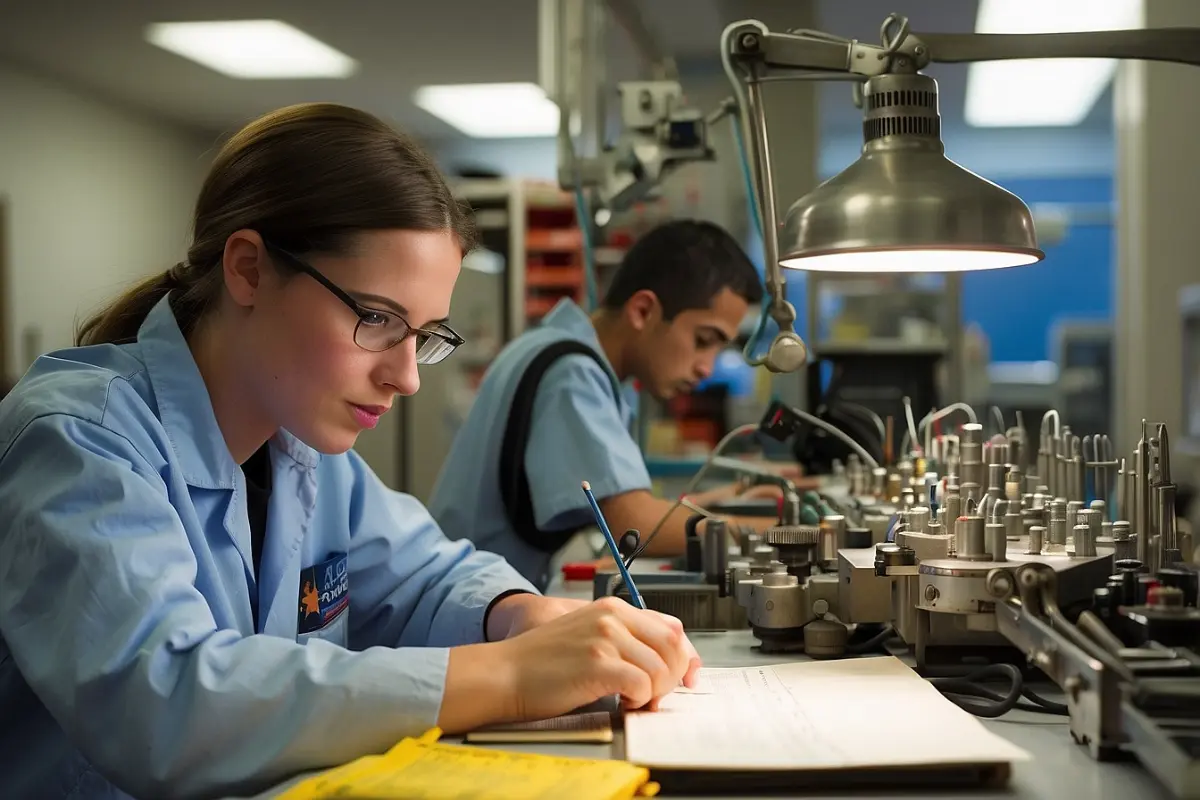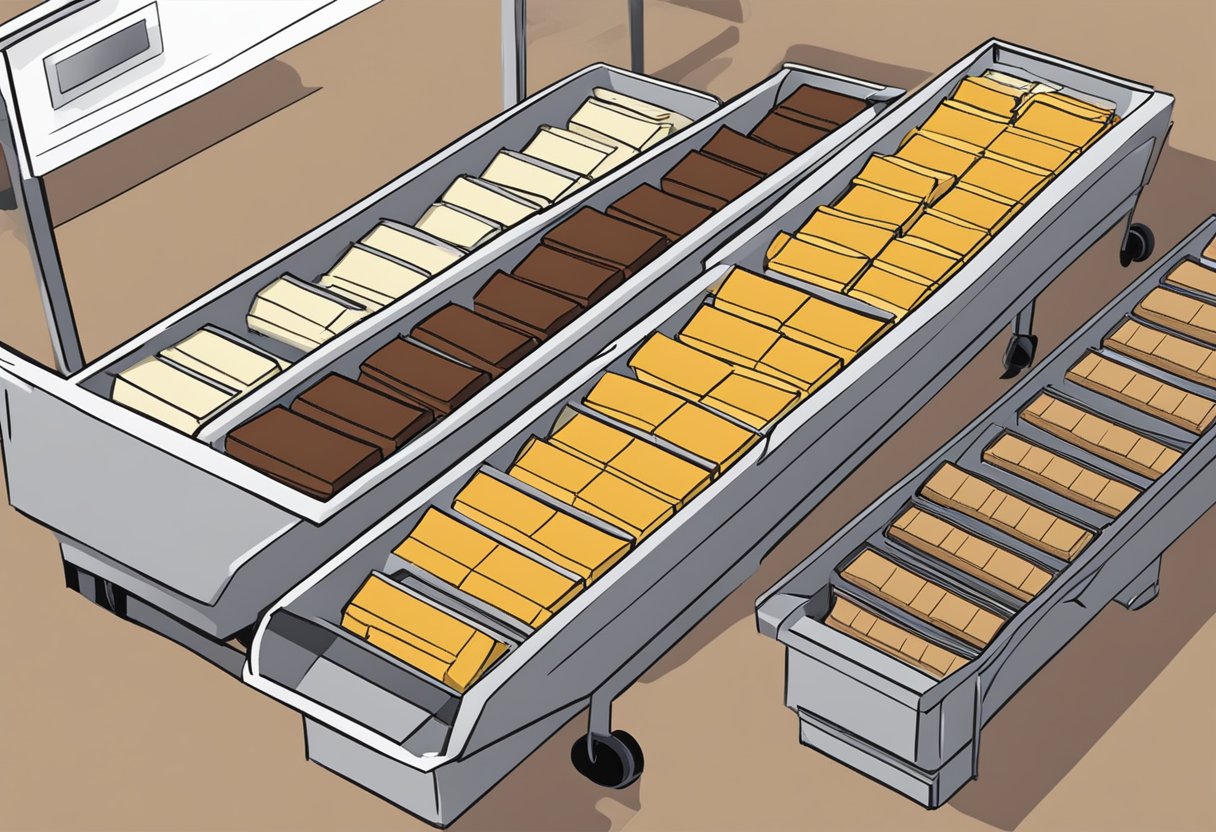
The Chocolate Factory Problem: Unwrapping the Role of Fascinating Fractions and Percentages
Table of Contents
The Chocolate Factory Problem: In exploring the realm of mathematics, we often come across engaging ways to present complex concepts such as fractions and percentages. Consider ‘The Chocolate Factory Problem’, which cleverly incorporates these mathematical ideas into a real-world scenario. The process of making chocolates often involves precise measurements and proportions, making it an ideal context for applying fractions and percentages. It’s fascinating how these numerical expressions become part of daily operations in a chocolate factory, demonstrating their practical importance beyond the classroom.

At the heart of understanding these concepts lies the ability to discern how they influence each other and the tasks we undertake. When we talk about breaking down ingredients into fractions or determining the percentage of cocoa in a chocolate bar, we are effectively contextualising mathematics in tangible experiences. This connection not only aids in learning but also instils a sense of relevance and purpose, thus enhancing retention and comprehension.
Key Takeaways
- Fractions and percentages are integral in chocolate making.
- Real-world contexts like a chocolate factory can aid mathematical understanding.
- Linking mathematics to practical scenarios enhances learning experiences.
Understanding Fractions
In this section, we’ll explore the fundamental aspects of fractions and how to seamlessly convert them into decimals, which is a critical skill in mathematics.
Basics of Fractions
A fraction represents a part of a whole or, more generally, any number of equal parts. It comprises two parts: the numerator, indicating the number of parts, and the denominator, showing how many of those parts make up a whole. When we talk about fractions, we’re dealing with pieces of a whole entity; for instance, if a chocolate bar is divided into four equal parts, each part would be described as a fraction (1/4) of the bar.
To fully grasp fractions, one must understand how to compare and reduce them to simplest form. Comparing involves looking at the size of fractions relative to each other, and reducing (or simplifying) means finding an equivalent fraction with the smallest possible numerator and denominator. Here’s a simple table to illustrate fraction reduction:
| Original Fraction | Reduced Fraction |
|---|---|
| 4/8 | 1/2 |
| 10/15 | 2/3 |
| 20/25 | 4/5 |
Converting Fractions to Decimals
Converting fractions into decimals is a simple yet vital process in mathematics because it allows for an easier comparison and use of numbers in various contexts. To convert a fraction to a decimal, we divide the numerator by the denominator. For instance, to convert 1/4 into a decimal, we divide 1 by 4, giving us 0.25. This can also be reversed to convert decimals into fractions; the decimal 0.75 can be expressed as the fraction 3/4 after some necessary multiplication.
It’s important to remember that some fractions convert to repeating decimals and may require rounding for practical use. An example is 1/3, which becomes 0.333… and is often rounded to 0.33 in daily applications.
Mastering Percentages
We’re going to tackle percentages head-on and break down the essentials you need to know. From the math classroom to the shopping realm, understanding how to work with percentages is a tool you’ll use time and time again.
Fundamentals of Percentages
Percentages represent a fraction of 100, making them a versatile tool for comparison and quantification. To convert a fraction to a percentage, you simply multiply the fraction by 100 and add a percentage sign. For instance, the fraction ½ becomes 50% after conversion.
In the context of Year 6 mathematics, the concept of percentages is particularly important as it builds on pupils’ knowledge of fractions and decimals – a critical part of their math curriculum.
Interpreting Percentages in Everyday Scenarios
When we apply percentages to everyday shopping, you begin to see their practical utility. For example, a 20% discount on an item priced at £50 means you save £10, paying only £40. This application demonstrates how percentages directly affect financial decisions.
Understanding percentages is also imperative when you’re dealing with year-on-year growth or decline, such as analysing a company’s annual report or evaluating changes in your savings account. Here, percentages can help you make informed decisions based on the trends you observe.
The Role of Fractions in Chocolate Making

In the delicate art of chocolate making, fractions are not just useful; they are essential. They ensure precision and consistency in every delectable piece that comes out of the factory.
Measuring Ingredients
Fractions come into play from the very beginning of the chocolate making process—measuring ingredients. We take great care in ensuring that each ingredient is measured accurately to maintain the perfect balance of flavours. For instance, the proportion of cocoa to sugar and milk, often listed in fractions on a recipe, dictates whether the chocolate will be dark, milk, or white. Precise fractional measurements guarantee the same mouth-watering taste in every batch.
- Cocoa powder: 1/4 cup
- Sugar: 1/2 cup
- Milk: 3/4 cup
Dividing Chocolate into Portions
Once we’ve crafted our chocolate mixture, division is critical when we’re splitting it into individual portions. Whether it’s bars or individual truffles, understanding and applying fractions ensure each piece is of equal size and weight. This isn’t just about aesthetics; it’s about guaranteeing an equitable experience for every chocolate lover.
- Large bar: 1/2 of the tray
- Medium bars: 1/4 of the tray
- Small squares: 1/8 of the tray
Using fractions is at the core of chocolate making, from measuring ingredients to the joy of breaking off a piece of a chocolate bar. Our adherence to these fractions is what makes our chocolate reliably delicious.
Practical Problems at the Chocolate Factory
In our chocolate factory, we encounter various challenges that require finesse in problem solving. From scheduling the shifts of our diligent employees to ensuring each chocolate bar is packaged to perfection, each task demands attention to detail and strategic planning.
Employee Shift Scheduling
The Complexities of Allocating Shifts: Our primary concern is to maintain a fair and efficient shift rota for our employees. To achieve this, we consider factors such as personal preferences, legal work-hour limits, and necessary skill distribution across shifts. For instance, we need to ensure that each shift has at least one employee skilled in tempering chocolate and another in quality control. Our goal is always to align employee schedules with our factory’s operational requirements while also respecting their work-life balance.
- Monday to Friday: Day Shift (8 hours), Night Shift (8 hours)
- Saturday: Half Shifts (4 hours only)
- Crucial Roles: 1 Tempering Specialist, 1 Quality Controller per shift
- Staff Well-being: Regular breaks, rotation of tasks
Chocolate Bar Packaging Challenges
Ensuring Consistency in Packaging: Our chocolate bars are our pride, and their packaging reflects our brand’s quality. A recurring problem involves attaining the right balance between aesthetic appeal and functional protection. The thickness of the foil wrap, the snugness of the outer sleeve, and the accuracy of the weight all come into play. Moreover, we aim to minimise waste during this process, optimising our packaging materials for sustainability.
- Quality checks: Weight consistency, seal integrity
- Packaging materials: Biodegradable foil, recycled paperboard
- Innovation: Trial of new eco-friendly packaging options
- Efficiency: Training sessions to decrease packaging time without compromising quality
We’ve found that maintaining high standards in shift scheduling and chocolate bar packaging is essential for the smooth operation of our chocolate factory. By addressing these practical problems with clear-headed strategies and a friendly approach, we ensure that every batch of chocolate bars is produced and packaged by happy, well-rested employees, which ultimately leads to a better product for our customers.
Educational Activities and Worksheets

In this section, we’ll explore engaging ways to blend the fun of chocolate with key mathematical concepts like fractions and percentages. These activities and worksheets are designed to enhance understanding and practice of these topics.
Fraction and Percentage Worksheets
We’ve developed a range of fraction and percentage worksheets that cater to different ability levels. Each worksheet offers an array of problems that challenge students to convert fractions to percentages, compare fraction sizes, and understand the real-world application of these mathematical concepts.
- Beginner Level: Focusing on simple conversions and comparisons to solidify the basics.
- Intermediate Level: Introducing more complex problems that involve equivalent fractions and percentage calculations.
- Advanced Level: Tackling real-world scenarios and multi-step problems for a deeper understanding.
Students may find particular interest in problems from a study into third graders’ approaches to fraction problems, which provides valuable insight into educational methods.
Fun with Chocolate Bar Fractions
Chocolate bar fractions turn learning into an enjoyable hands-on experience. Our activities include:
- Dividing Chocolate Bars: Physically cutting chocolate bars into pieces to discover fraction sizes.
- Fraction Hunt: A game where children find different fractions of chocolate bars hidden around the classroom.
By actually dividing a chocolate bar, students can visualise fractions more concretely, similar to an educational approach discussed in a research project. This method consolidates the understanding of equal parts and introduces the notion of sharing in practical terms.
Interactive Learning: Games and Flashcards

In addressing The Chocolate Factory Problem, we find that interactive tools like games and flashcards are invaluable in making the concepts of fractions and percentages engaging and memorable for learners.
Fraction Games
We have crafted a series of innovative fraction games designed to simplify the journey of learning how to add fractions and understand them in a real-world context. Imagine a game where one navigates through a chocolate factory, combining ingredients in fractions to create the perfect chocolate bar. By presenting fractions as parts of a wholesome treat, our games offer immediate, visual reinforcement of the concepts, making the learning process both fun and effective.
Percentage Flashcards
Meanwhile, our percentage flashcards are a dynamic tool for practice and quick revision. Picture a stack of vivid cards, each depicting a different percent, which one can use to solve problems relevant to The Chocolate Factory scenario, such as calculating the cocoa content in a chocolate mixture. This tactile method supports the retention of percentage knowledge and can be easily integrated into hands-on learning sessions.
Every game and flashcard set we develop is intended to bridge the gap between abstract mathematical concepts and their practical applications. We’re committed to creating resources that sparkle with creativity, encouraging every learner to explore mathematics with enthusiasm and confidence.
Percentage and Fraction Word Problems
Engaging with word problems that involve percentages and fractions can greatly enhance a student’s practical understanding of mathematics, especially when the context is as relatable as shopping and chocolate.
Shopping with Percentages
When we’re out shopping, percentages often dictate how we spend our money and make choices. Imagine you’re at the supermarket, faced with various discounts on chocolate bars. A sign reads “25% off the original price.” If the original price is £4, how much do you pay after the discount? To solve this, you’ll need to calculate £4 * 25% = £1, then subtract that from the original price, so you pay only £3.
Word Problems Involving Chocolate
Now let’s turn our attention to some delicious word problems involving chocolate. Suppose you and a friend have one whole chocolate bar and one-fourth of another one. To share these equally, you’d need to understand fractions and percentages. If a chocolate bar represents 100%, half a bar would be 50%, and an eighth—an additional splitting of the quarters—would be 12.5%. Playing with these concepts helps us not just solve problems, but also to practically divide and enjoy treats fairly.
Incorporating Themes into ELA and Science

We aim to weave fascinating themes into the fabric of both English Language Arts (ELA) and Science, thereby enriching the learning experience. Let’s connect the thrills of a chocolate factory with academic concepts in reading comprehension and scientific measurement.
Reading Comprehension: Charlie and the Chocolate Factory
Roald Dahl’s Charlie and the Chocolate Factory offers an exquisite playground to enhance reading comprehension. As we delve into the narrative, our focus sharpens on extracting themes and understanding character motivations. We’ll dissect plot elements and apply fraction-based problems found within the storyline—how many parts of the factory does each Golden Ticket winner get to see? This serves as a springboard for discussing theme integration and fraction use in a tangible context.
Scientific Measurement in Candy Making
Incorporating scientific measurement into sweet confections turns a chocolate obsession into an educational opportunity. We’ll measure ingredients with precision, employing grams and millilitres, to understand the importance of accuracy in recipes. This hands-on approach solidifies the concept of fractions and percentages linked to correct proportions and recipe scaling, transforming the act of making chocolate into an interactive science experiment.
Applying Fractions and Percentages in Real Life

In everyday life, we frequently use fractions and percentages without even realising it. Whether we’re cooking or managing finances, these mathematical concepts are essential tools for making informed decisions and understanding the world around us.
Cooking with Chocolate
When we bake a chocolate cake, we use fractions to measure ingredients. For instance, we might need ¾ of a cup of cocoa powder or ½ a teaspoon of baking powder. By following a recipe, we’re applying fractions to ensure the right proportions, so our cake turns out perfect. Similarly, adjusting a recipe for more or fewer people requires multiplying or dividing these fractions, which demonstrates their practical application in the kitchen.
Managing Finances through Percentages
Percentages are integral in finance for everything from calculating the interest on savings to understanding how much VAT we’re paying. For example, if we receive a bank statement indicating an annual interest rate of 2% on our savings, we’re looking at how a fraction—2 per 100—of our money is added over time as interest. Managing a budget effectively also entails working out percentages for different expenses, making these calculations key to financial literacy in real-life situations.
In every aspect of real life, be it in cooking or finance, fractions and percentages are not just numbers on a page — they’re part of our daily decision-making process. We work with them to make our lives easier and more efficient, applying these concepts to make sense of quantities and changes in our environment.
Creating Instructional Material

When we create instructional material for teaching fractions and percentages, especially in a context like the Chocolate Factory Problem, it’s imperative to ensure that these resources are engaging and conducive to learning. Materials should allow for a flexible approach to problem-solving and cater to various learning styles.
Designing Editable Worksheets
We carefully design editable worksheets that enable educators to tailor questions to the specific needs of their class. For example, we might include a table where teachers can modify the quantities of chocolate bars and alter the percentage of cocoa content, allowing students to practise their fraction and percentage calculations in a dynamic way. Ensuring these worksheets are editable also allows for differentiation, providing opportunities to both support and challenge pupils at different levels.
Answer Keys and Solutions
Alongside the worksheets, providing comprehensive answer keys and solutions is crucial. These not only facilitate marking but also help students in understanding the steps and methods used to reach the correct answers. It’s essential to present answers in a clear format, utilising lists or tables to display calculations and results step-by-step, which reinforces the learning outcomes and aids understanding of the underlying mathematical concepts.
Frequently Asked Questions
In this FAQ section, we’ll tackle the specific maths challenges of fractions and percentages within a chocolate factory context.
How can we calculate the proportion of ingredients in a chocolate recipe using fractions?
To calculate the proportion of ingredients, we assess the total amount of the mixture and represent each ingredient’s quantity as a fraction of this total. For instance, if cacao forms half of the total weight, we express it as 1/2.
What methods are used to solve fractional problems in chocolate production scenarios?
During chocolate production, methods such as the equivalent fractions concept are employed to adjust batch sizes or mix ingredients in various proportions. Visual representations can be particularly helpful in these scenarios.
In what ways do percentages play a role in the operation of a chocolate factory?
Percentages are crucial for tasks such as quality control, where a certain percentage of products are sampled. They also determine the cacao content in chocolate, where a 70% cacao bar has 70% of its weight derived from cacao beans.
What are some common challenges when teaching fractions and percentages through real-world problems like a chocolate factory?
A challenge is ensuring that students can transfer mathematical concepts, like dividing fractions, to practical situations, such as sharing a batch of chocolate evenly. It’s important for teaching strategies to include realistic problems to aid understanding.
How can one convert between fractions and percentages to solve problems related to chocolate manufacturing?
One converts fractions to percentages by multiplying the fraction by 100. To find what percentage of a chocolate bar is nuts if 1/4 of it is nuts, you’d calculate (1/4) * 100 = 25%.
What are effective strategies for optimising chocolate production using mathematical concepts of fractions and percentages?
Strategies include calculating the most efficient ingredient ratios or maximising output given finite resources. Using mathematical reasoning with multiplicative relationships and scaling can lead to more effective production processes.


Leave a Reply